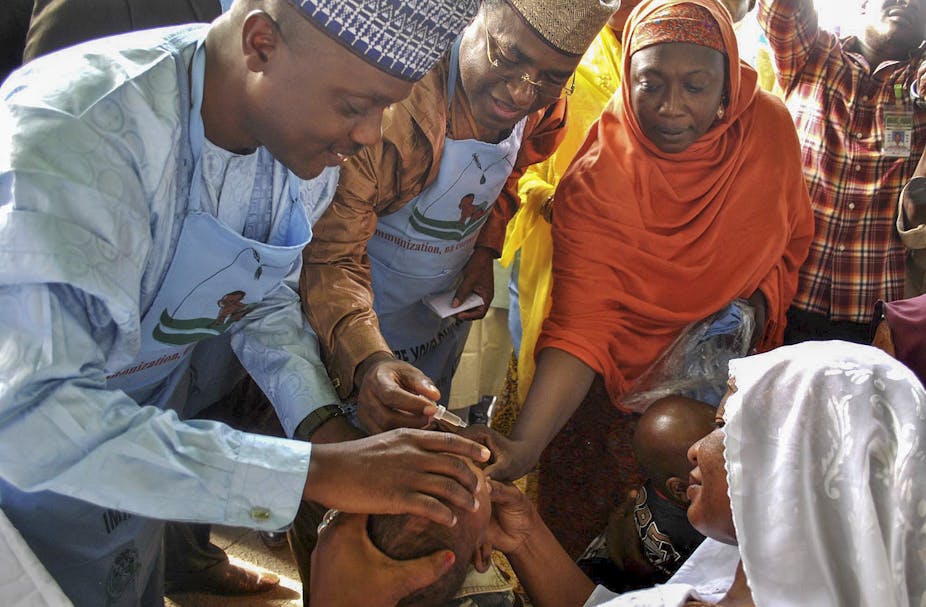The campaign to eradicate polio in Africa has had a number of positive spinoffs for the health sector on the continent. Chief among these have been community involvement, multi-disciplinary partnerships, improved health care and the strengthening of health systems.
For decades, polio took a heavy toll on both children and adults. Before the development of two polio vaccines in the 1950s and the 1960s, about half a million people a year were paralysed or died. Today, more than 10 million people who would otherwise have been paralysed by the virus are able to walk because of these vaccines.
Globally, more than US$9 billion has been ploughed into polio eradication since the the 1980s. This has resulted in more than 2.5 billion children being immunised against polio. The Global Polio Eradication Initiative estimates that it has already generated benefits worth $27 billion through its vaccination campaigns and the deaths it averts. The administration of vitamin A during these campaigns has also helped.
But in addition to the humanitarian and financial benefits, anti-polio campaigns have also had a positive impact on health services and the development of health infrastructure.
A more involved community
The greatest positive impact has been in community mobilisation and multi-disciplinary partnerships. These are inseparable pillars of primary health care and two strategies that have proved the most difficult to implement.
Within community mobilisation, the main elements are strengthening existing community organisations, using educational campaigns and advocating the involvement of political and community leaders. Through the polio eradication campaigns, these approaches have been successfully adopted by other health programmes.
Involving the community ensures two things. First, people are motivated to bring their children to be vaccinated during mass campaigns. They also continue to bring their children for routine vaccination visits after the campaigns.
Second, these communities become actively involved in the campaigns. They often help deliver vaccines, maintain the vaccine cold chain and avail their own resources to campaigns, forming an active part of the vaccine supply chain.
In Nigeria, for example, community members donated money, used their vehicles, volunteered their time and availed personal resources for these operations. On occasion, this cost them their own lives. Many vaccinators in Nigeria were killed in targeted assassinations.
A good proportion of vaccine storage equipment used in immunisation programmes across Africa, such as cold stores, freezers and refrigerators as well as transporting equipment such as coolers, vaccine carriers and ice packs, were procured in the polio eradication initiative.
Improved health care services
Polio eradication has helped raise the profile of the public health sector. It has done this by creating a renewed demand for vaccination services, resulting in higher routine vaccine coverage.
But the model has also shown innovative ways to deliver health services. For example, to increase the coverage of vaccine in security-affected states in Nigeria, federal and state governments developed a specific strategy in those parts of the country. Known as “hit and run”, local vaccinators would move into a rural area in the morning, vaccinate children speedily and leave as soon as possible.
Some health programmes have taken on features developed for the polio eradication initiative, such as:
setting up partnerships between agencies, disciplines and sectors;
engaging the media and improving communication systems to reach entire populations;
increasing community involvement;
creating innovative knowledge management systems;
improving programme management capacity; and
establishing high-quality disease surveillance.
It has also helped to pinpoint gaps and weaknesses in health service delivery and in many cases helped to fill these gaps. This includes strengthening the supply chain processes.
And like the campaign to eliminate smallpox, the global polio campaign also brought health services to under-serviced populations, such as children trapped in war zones. In the lead-up to the Muslim religious holiday Eid earlier this year, a humanitarian pause allowed 50,000 children to receive polio vaccines in Yemen.
Towards a polio-free world
Important lessons were also learnt at the international level. The World Health Organisation has successfully brought together an unprecedented global team. It includes governments, other UN agencies, non-governmental organisations, community groups, the business community and religious organisations.
A new strategic plan has been developed to ensure successful worldwide eradication of polio by 2018. The plan was created along with polio-affected countries, donors and national and international advisory bodies. It is the first plan designed to eradicate all types of the polio disease from wild poliovirus to vaccine derived polioviruses.
Once polio is eradicated, the world can celebrate the delivery of a major global public good benefiting all equally. But most importantly, success will mean that no child will ever again endure the misery of lifelong polio paralysis.

